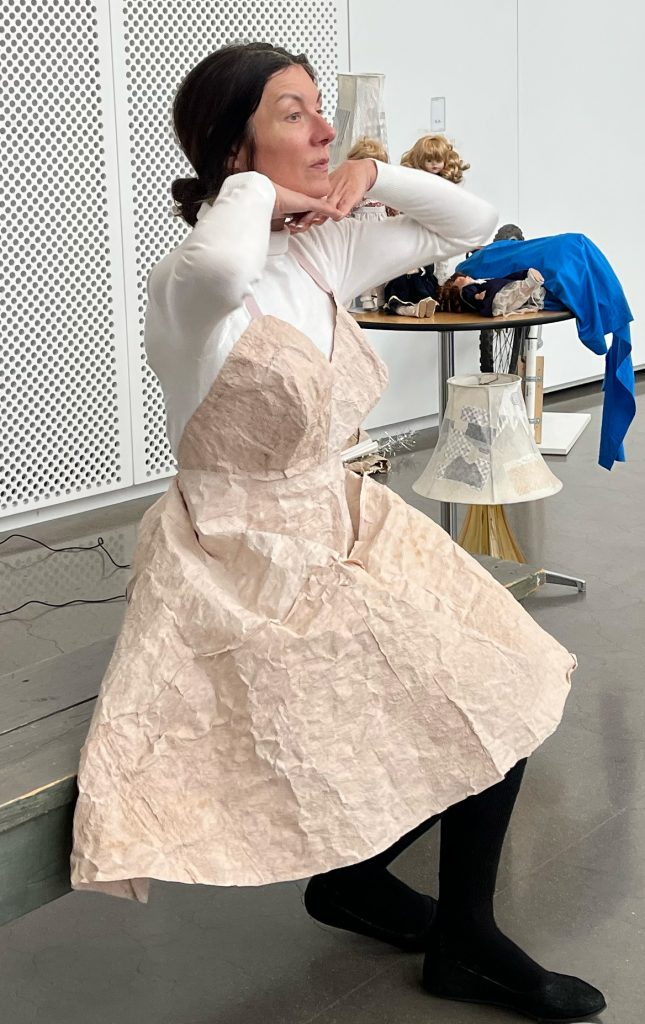Costume Design
Interview with Alyssa Ridder
Costume Designer for The Plays of Mina Loy
My process was heavily inspired by the work of the dramaturgs. I read through everything that they had provided, engaged with their images and materials, their questions. These are my notes as we discussed Sacred Prostitute:
Taking off masculinity to reveal fragility…Claude Cahun, boxing, wandering nipples… performance of gender, paper version of love to put in the pocket. Dolls, mannequins, papers, folding, manuscripts. Love is a manuscript, manuscripts in a body shaped sack. Love is hermaphroditic, then revealed. Another note about a body suit of muscles, doesn’t matter the gender, the metaphor of boxing, not conforming, disguised shapes, lamp shade hats.
We had lots of discussions about seeing Loony as Futurism and portraying Love as a paper doll. Shifting from being written as a paper doll to being embodied really shifted the understanding of what that piece was and let us see the humor in it.
I was also very inspired by the text in Loy’s plays. I wrote in my notes “clothes are alive” when exploring the line “the social curtain is a fabric.” All my preparation was in trying to understand Mina Loy and how she worked, the context of her work, and the imagery involved. That preparatory work didn’t come together until we were all in the room, and I realized these actors need help. They also are oversaturated with these very complicated pieces and don’t understand what’s happening. I sketched the boxy man and the paper dress during the rehearsal. I approached the design as a way to see what could be filtered out, looking to find one thing that we could make concrete. In the case of Love in Sacred Prostitute, she needs to be both masculine and feminine, hermaphroditic. I felt like the fit and flare was an important shape, as it looks like the symbol on a women’s restroom, a very generic hourglass shape. The top hat was also important as surface-level “put on” masculinity. There is freedom in releasing yourself from realism. That’s an important part of this: releasing yourself from really understanding the meaning of something before you’ve made it. Another key element is working with what you have. The dress was made from paper and that was important because of the use of paper in Loy’s work but also because the paper was a resource we had available. I find it interesting that this paper costume is a representation of the perception of feminine fragility, but that costume has now lasted through three separate productions which is a testament to how structurally sound that paper is.

The whole process was about exploring what you’re responding to and letting it happen organically. This is in contrast to how I’ve worked in very conventional patriarchal theatre where we all go and organize ourselves into boxes and then we stack our boxes together. The process of working on the Loy plays was more of a weaving; letting all the voices speak and not claiming territory. Embracing Loy’s feminist approach was what helped me release the pressures of the patriarchal production structure in order to honor the intention of these plays.

The costume design for the 2023 production of The Sacred Prostitute was inspired by Loy’s painting, L’Amour dorloté par les Belles Dames (1906), and the photography of Claude Cahun.
Claude Cahun was an early 20th-century artist who worked in sculpture, photography, writing, and theatre. Born Lucy Renee Mathilde Schwob in France in 1894 to an upper-class family, Cahun lived until age 60 before dying on December 8, 1954. Cahun often explored gender expression through their work and life but referred to themselves as “she” in her writing. Besides Cahun’s artistic work, she was also a political activist during World War II. Cahun lived much of her life in Paris with Marcel Moore, her romantic and artistic partner. Many of Cahun’s self-portraits are done in costumes to express Cahun’s gender fluidity and interest in Surrealism.

